 | –≠–ª–µ–∫—Ç—Ä–æ–Ω–Ω—ã–π –∫–æ–º–ø–æ–Ω–µ–Ω—Ç: LMC6022I | –°–∫–∞—á–∞—Ç—å:  PDF PDF  ZIP ZIP |
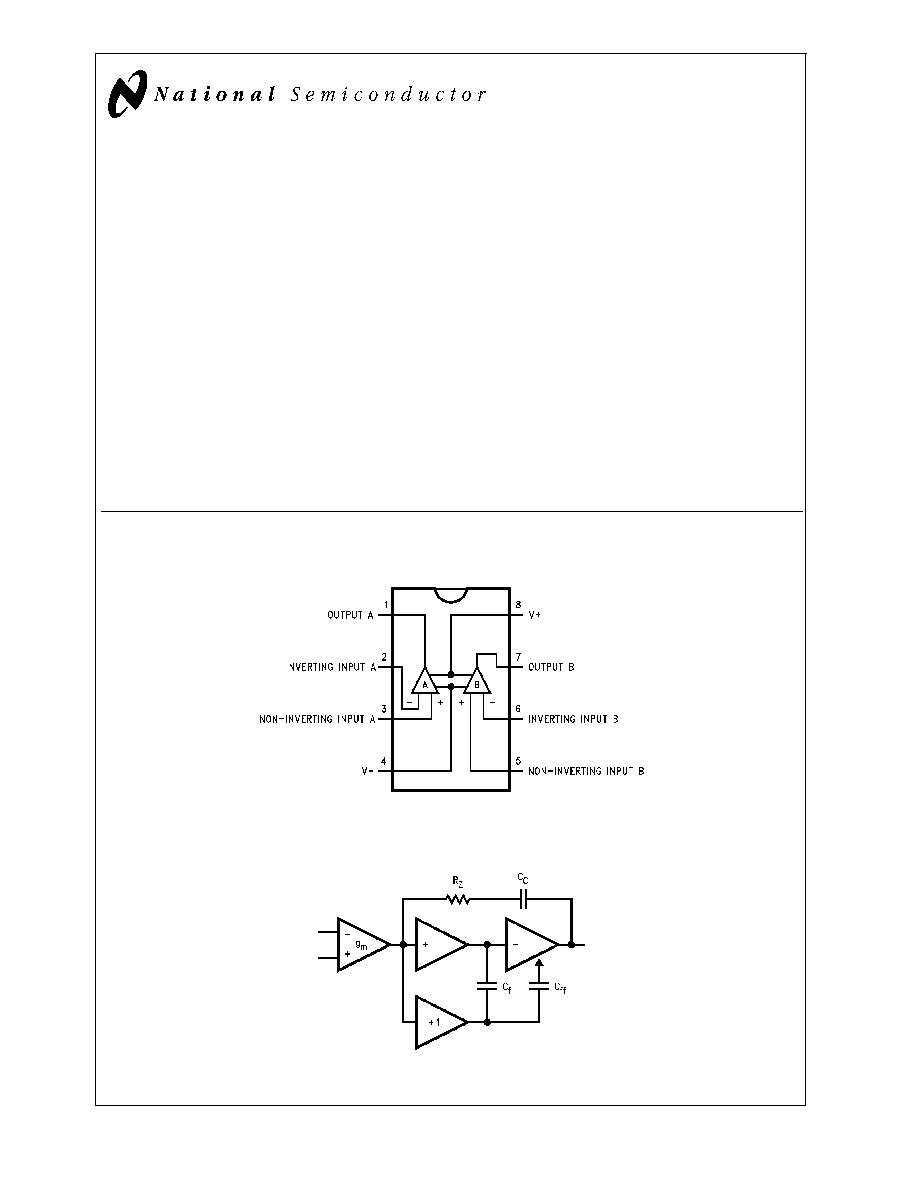
LMC6022
Low Power CMOS Dual Operational Amplifier
General Description
The LMC6022 is a CMOS dual operational amplifier which
can operate from either a single supply or dual supplies. Its
performance features include an input common-mode range
that reaches V
-
, low input bias current, and voltage gain (into
100k and 5 k
loads) that is equal to or better than widely
accepted bipolar equivalents, while the power supply re-
quirement is less than 0.5 mW.
This chip is built with National's advanced Double-Poly
Silicon-Gate CMOS process.
See the LMC6024 datasheet for a CMOS quad operational
amplifier with these same features.
Features
n
Specified for 100 k
and 5 k
loads
n
High voltage gain:
120 dB
n
Low offset voltage drift:
2.5 µV/∞C
n
Ultra low input bias current:
40 fA
n
Input common-mode range includes V
-
n
Operating range from +5V to +15V supply
n
Low distortion:
0.01% at 1 kHz
n
Slew rate:
0.11 V/µs
n
Micropower operation:
0.5 mW
Applications
n
High-impedance buffer or preamplifier
n
Current-to-voltage converter
n
Long-term integrator
n
Sample-and-hold circuit
n
Peak detector
n
Medical instrumentation
n
Industrial controls
Connection Diagram
8-Pin DIP/SO
DS011236-1
Top View
LMC6022 Circuit Topology (Each Amplifier)
DS011236-6
August 2000
LMC6022
Low
Power
CMOS
Dual
Operational
Amplifier
© 2000 National Semiconductor Corporation
DS011236
www.national.com
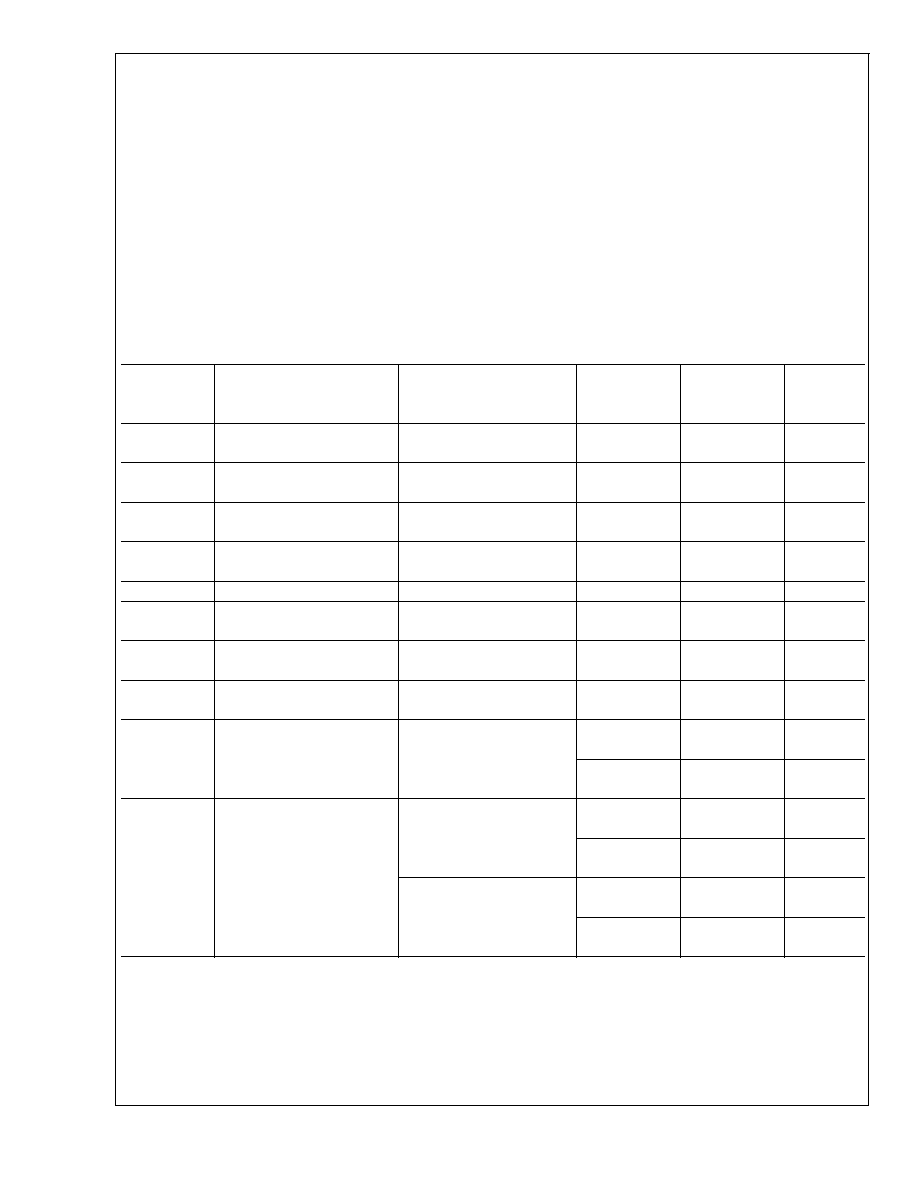
Absolute Maximum Ratings
(Note 1)
Differential Input Voltage
±
Supply Voltage
Supply Voltage (V
+
- V
-
)
16V
Lead Temperature
(Soldering, 10 sec.)
260∞C
Storage Temperature Range
-65∞C to +150∞C
Junction Temperature
150∞C
ESD Tolerance (Note 4)
1000V
Voltage at Output/Input Pin
(V
+
) +0.3V, (V
-
) -0.3V
Current at Output Pin
±
18 mA
Current at Power Supply Pin
35 mA
Power Dissipation
(Note 3)
Current at Input Pin
±
5 mA
Output Short Circuit to V
-
(Note 2)
Output Short Circuit to V
+
(Note 12)
Operating Ratings
Temperature Range
-40∞C
T
J
+85∞C
Supply Voltage Range
4.75V to 15.5V
Power Dissipation
(Note 10)
Thermal Resistance (
JA
), (Note 11)
8-Pin DIP
101∞C/W
8-Pin SO
165∞C/W
DC Electrical Characteristics
The following specifications apply for V
+
= 5V, V
-
= 0V, V
CM
= 1.5V, V
O
= 2.5V, and R
L
= 1M unless otherwise noted. Bold-
face limits apply at the temperature extremes; all other limits T
J
= 25∞C.
Symbol
Parameter
Conditions
Typical
(Note 5)
LMC6022I
Units
Limit
(Note 6)
V
OS
Input Offset Voltage
1
9
mV
11
max
V
OS
/
T
Input Offset Voltage
2.5
µV/∞C
Average Drift
I
B
Input Bias Current
0.04
pA
200
max
I
OS
Input Offset Current
0.01
pA
100
max
R
IN
Input Resistance
>
1
Tera
CMRR
Common Mode
0V
V
CM
12V
83
63
dB
Rejection Ratio
V
+
= 15V
61
min
+PSRR
Positive Power Supply
5V
V
+
15V
83
63
dB
Rejection Ratio
61
min
-PSRR
Negative Power Supply
0V
V
-
-10V
94
74
dB
Rejection Ratio
73
min
V
CM
Input Common-Mode
V
+
= 5V & 15V
-0.4
-0.1
V
Voltage Range
For CMRR
50 dB
0
max
V
+
- 1.9
V
+
- 2.3
V
V
+
- 2.5
min
A
V
Large Signal
R
L
= 100 k
(Note 7)
1000
200
V/mV
Voltage Gain
Sourcing
100
min
Sinking
500
90
V/mV
40
min
R
L
= 5 k
(Note 7)
1000
100
V/mV
Sourcing
75
min
Sinking
250
50
V/mV
20
min
LMC6022
www.national.com
2
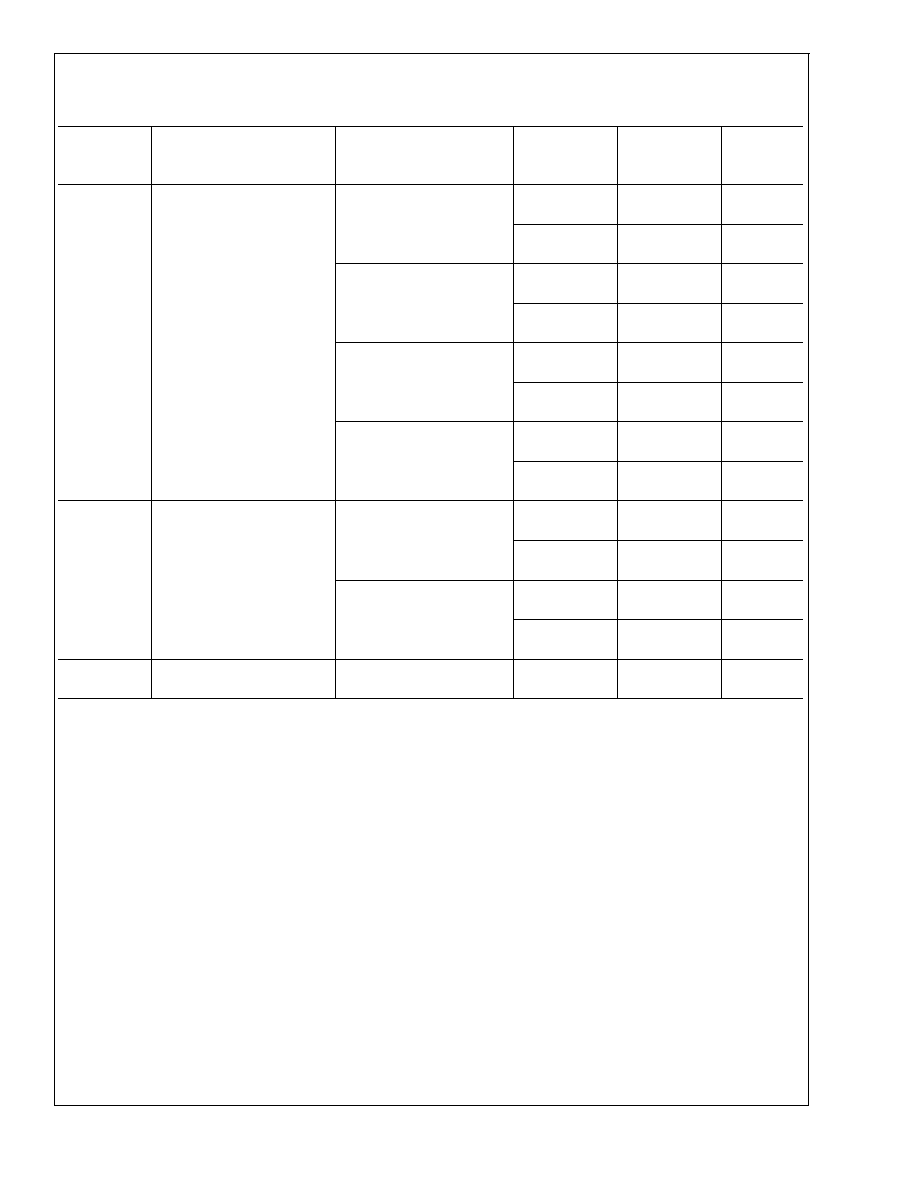
DC Electrical Characteristics
(Continued)
The following specifications apply for V
+
= 5V, V
-
= 0V, V
CM
= 1.5V, V
O
= 2.5V, and R
L
= 1M unless otherwise noted. Bold-
face limits apply at the temperature extremes; all other limits T
J
= 25∞C.
Symbol
Parameter
Conditions
Typical
(Note 5)
LMC6022I
Units
Limit
(Note 6)
V
O
Output Voltage Swing
V
+
= 5V
4.987
4.40
V
R
L
= 100 k
to 2.5V
4.43
min
0.004
0.06
V
0.09
max
V
+
= 5V
4.940
4.20
V
R
L
= 5 k
to 2.5V
4.00
min
0.040
0.25
V
0.35
max
V
+
= 15V
14.970
14.00
V
R
L
= 100 k
to 7.5V
13.90
min
0.007
0.06
V
0.09
max
V
+
= 15V
14.840
13.70
V
R
L
= 5 k
to 7.5V
13.50
min
0.110
0.32
V
0.40
max
I
O
Output Current
V
+
= 5V
22
13
mA
Sourcing, V
O
= 0V
9
min
Sinking, V
O
= 5V
21
13
mA
(Note 2)
9
min
V
+
= 15V
40
23
mA
Sourcing, V
O
= 0V
15
min
Sinking, V
O
= 13V
39
23
mA
(Note 12)
15
min
I
S
Supply Current
Both Amplifiers
86
140
µA
V
O
= 1.5V
165
max
LMC6022
www.national.com
3

AC Electrical Characteristics
The following specifications apply for V
+
= 5V, V
-
= 0V, V
CM
= 1.5V, V
O
= 2.5V, and R
L
= 1M unless other otherwise noted.
Boldface limits apply at the temperature extremes; all other limits T
J
= 25∞C.
Symbol
Parameter
Conditions
Typical
(Note 5)
LMC6022I
Units
Limit
(Note 6)
SR
Slew Rate
(Note 8)
0.11
0.05
V/µs
0.03
min
GBW
Gain-Bandwidth Product
0.35
MHz
M
Phase Margin
50
Deg
G
M
Gain Margin
17
dB
Amp-to-Amp Isolation
(Note 9)
130
dB
e
n
Input-Referred Voltage Noise
F = 1 kHz
42
i
n
Input-Referred Current Noise
F = 1 kHz
0.0002
Note 1: Absolute Maximum Ratings indicate limits beyond which damage to component may occur. Operating Ratings indicate conditions for which the device is in-
tended to be functional, but do not guarantee specific performance limits. For guaranteed specifications and test conditions, see the Electrical Characteristics. The
guaranteed specifications apply only for the test conditions listed.
Note 2: Applies to both single-supply and split-supply operation. Continuous short circuit operation at elevated ambient temperature and/or multiple Op Amp shorts
can result in exceeding the maximum allowed junction temperature of 150∞C. Output currents in excess of
±
30 mA over long term may adversely affect reliability.
Note 3: The maximum power dissipation is a function of T
J(max)
,
JA
and T
A
. The maximum allowable power dissipation at any ambient temperature is P
D
= (T
J(max)
- T
A
)/
JA
.
Note 4: Human body model, 100 pF discharged through a 1.5 k
resistor.
Note 5: Typical values represent the most likely parametric norm.
Note 6: All limits are guaranteed by testing or correlation.
Note 7: V
+
= 15V, V
CM
= 7.5V, and R
L
connected to 7.5V. For Sourcing tests, 7.5V
V
O
11.5V. For Sinking tests, 2.5V
V
O
7.5V.
Note 8: V
+
= 15V. Connected as Voltage Follower with 10V step input. Number specified is the slower of the positive and negative slew rates.
Note 9: Input referred. V
+
= 15V and R
L
= 100 k
connected to 7.5V. Each amp excited in turn with 1 kHz to produce V
O
= 13 V
PP
.
Note 10: For operating at elevated temperatures the device must be derated based on the thermal resistance
JA
with P
D
= (T
J
-T
A
)/
JA
.
Note 11: All numbers apply for packages soldered directly into a PC board.
Note 12: Do not connect output to V
+
when V
+
is greater than 13V or reliability may be adversely affected.
LMC6022
www.national.com
4

Typical Performance Characteristics
V
S
=
±
7.5V, T
A
= 25∞C unless otherwise specified
Supply Current
vs Supply Voltage
DS011236-27
Input Bias Current
vs Temperature
DS011236-28
Input Common-Mode
Voltage Range vs
Temperature
DS011236-29
Output Characteristics
Current Sinking
DS011236-30
Output Characteristics
Current Sourcing
DS011236-31
Input Voltage Noise
vs Frequency
DS011236-32
LMC6022
www.national.com
5
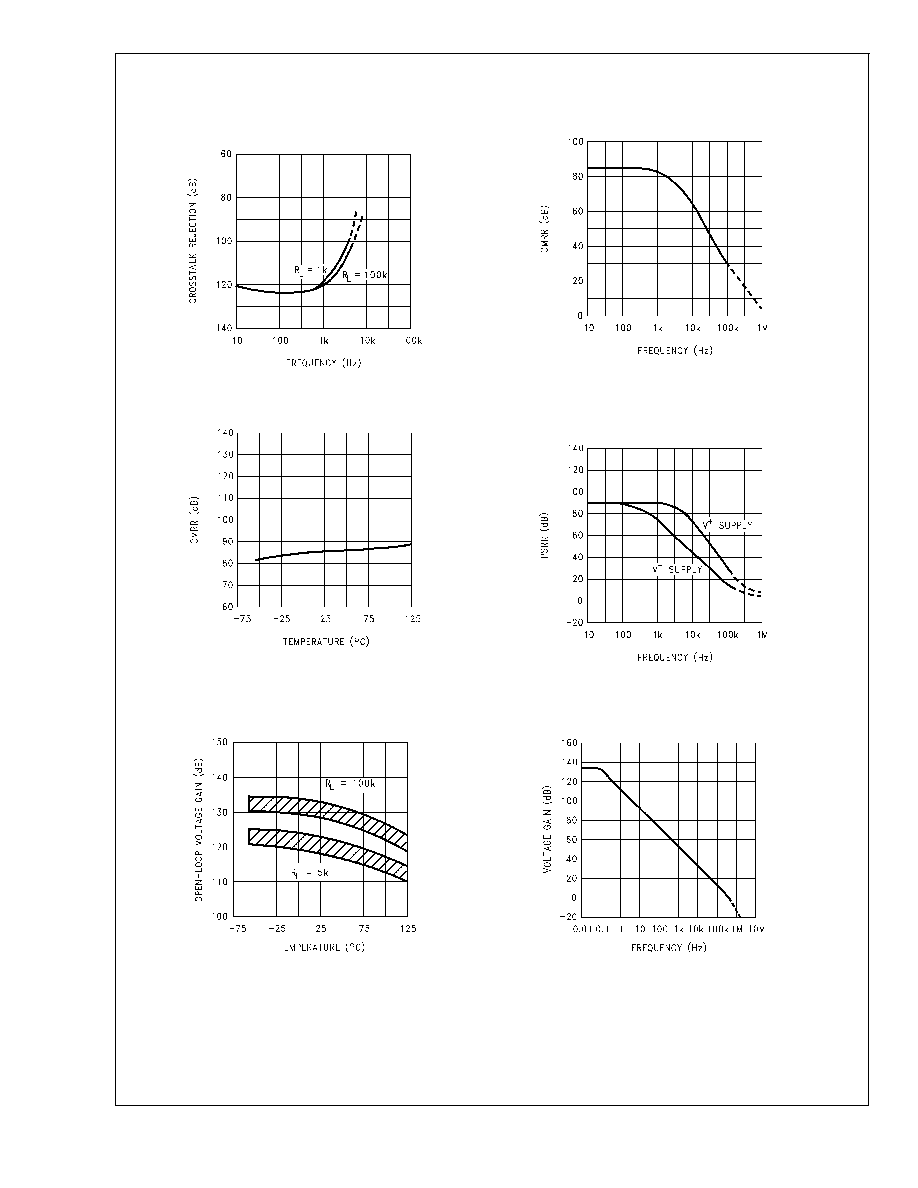
Typical Performance Characteristics
V
S
=
±
7.5V, T
A
= 25∞C unless otherwise specified (Continued)
Crosstalk Rejection
vs Frequency
DS011236-33
CMRR vs Frequency
DS011236-34
CMRR vs Temperature
DS011236-35
Power Supply Rejection
Ratio vs Frequency
DS011236-36
Open-Loop Voltage Gain
vs Temperature
DS011236-37
Open-Loop
Frequency Response
DS011236-38
LMC6022
www.national.com
6
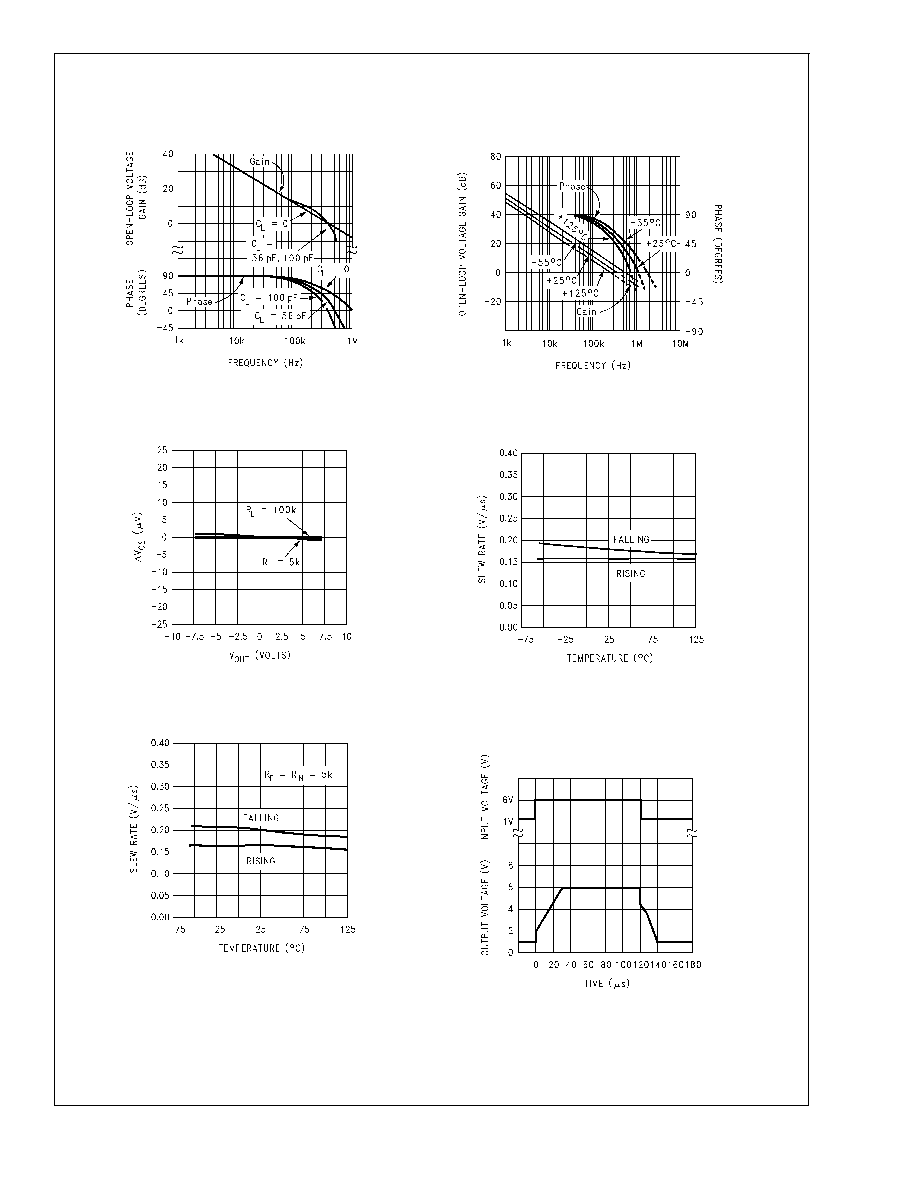
Typical Performance Characteristics
V
S
=
±
7.5V, T
A
= 25∞C unless otherwise specified (Continued)
Gain and Phase Responses
vs Load Capacitance
DS011236-39
Gain and Phase Responses
vs Temperature
DS011236-40
Gain Error
(V
OS
vs V
OUT
)
DS011236-41
Non-Inverting Slew Rate
vs Temperature
DS011236-42
Inverting Slew Rate
vs Temperature
DS011236-43
Large-Signal Pulse
Non-Inverting Response
(A
V
= +1)
DS011236-44
LMC6022
www.national.com
7
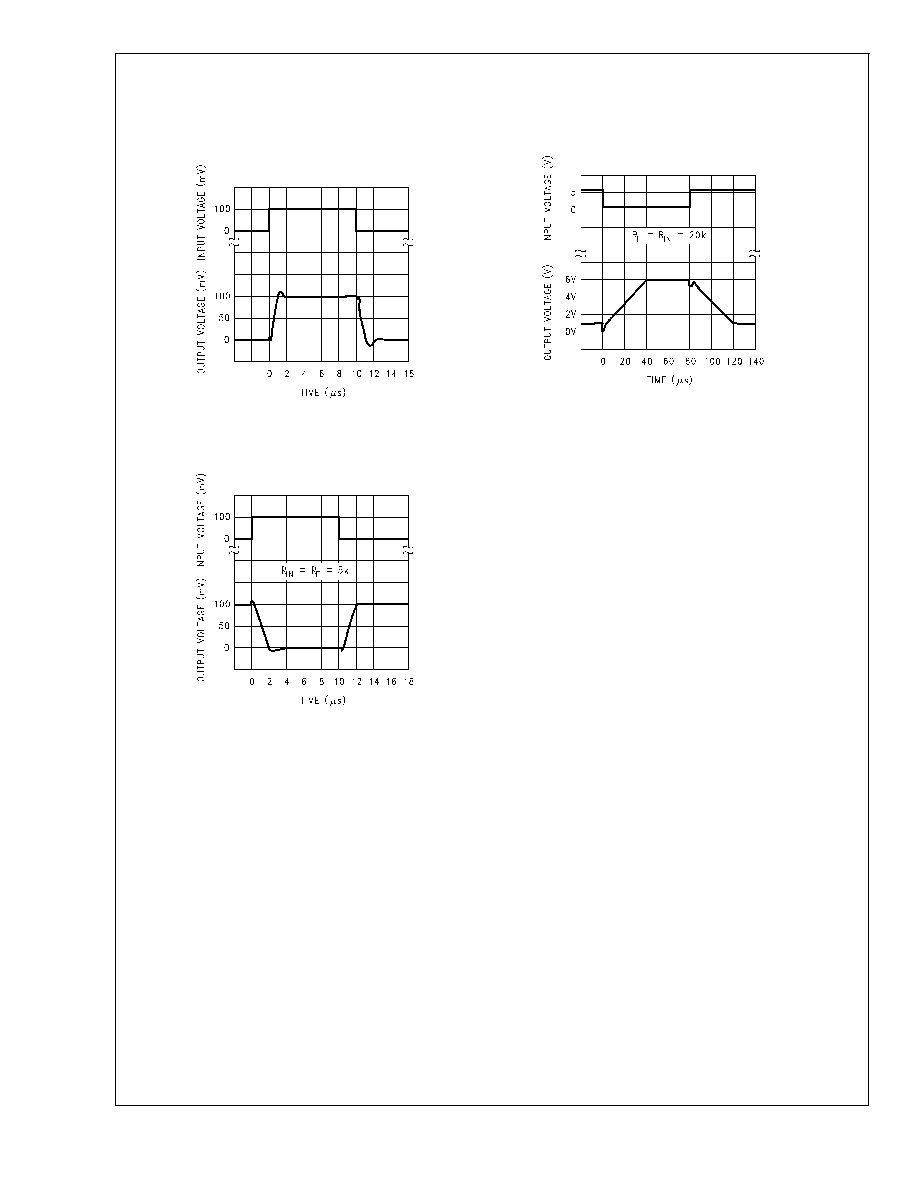
Typical Performance Characteristics
V
S
=
±
7.5V, T
A
= 25∞C unless otherwise specified (Continued)
Non-Inverting Small
Signal Pulse Response
(A
V
= +1)
DS011236-45
Inverting Large-Signal
Pulse Response
DS011236-46
Inverting Small-Signal
Pulse Response
DS011236-47
LMC6022
www.national.com
8
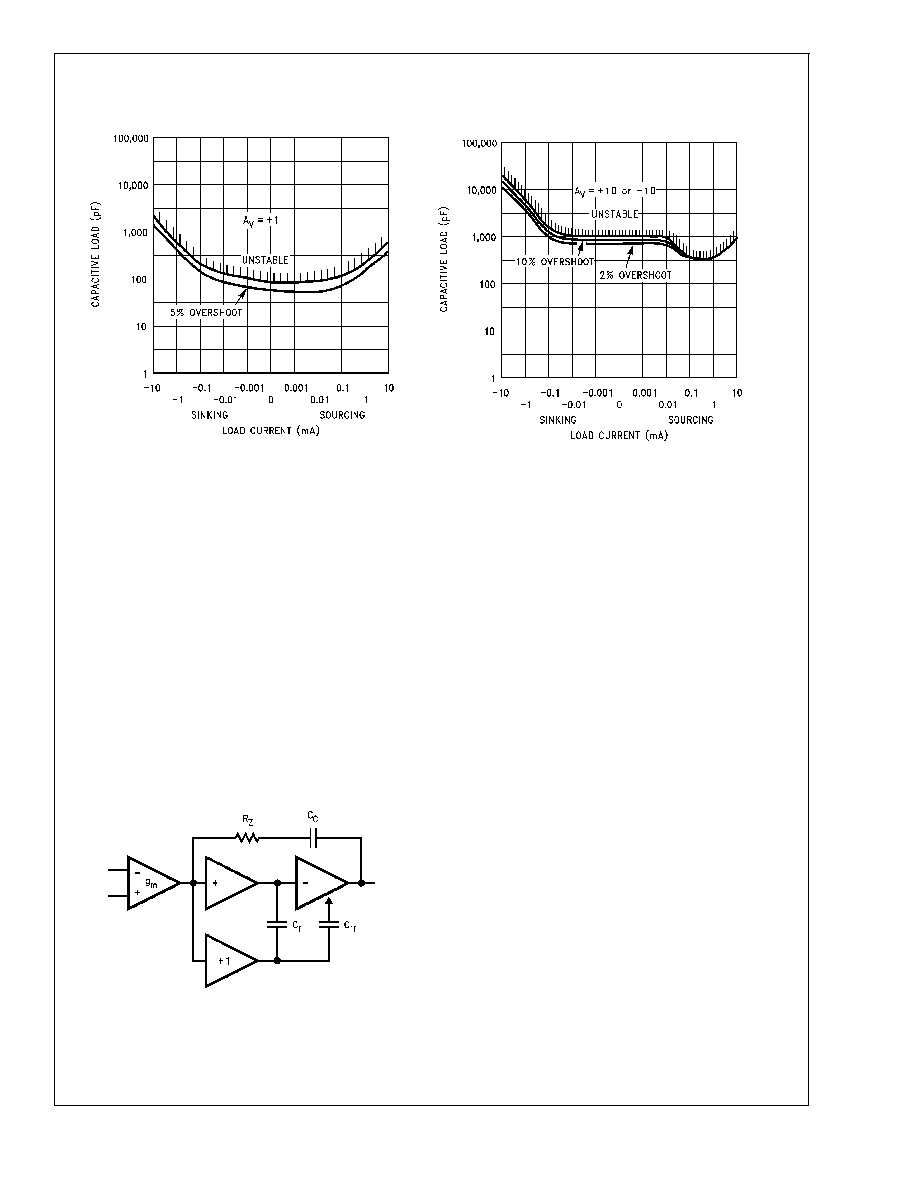
Typical Performance Characteristics
V
S
=
±
7.5V, T
A
= 25∞C unless otherwise specified (Continued)
Application Hints
AMPLIFIER TOPOLOGY
The topology chosen for the LMC6022 is unconventional
(compared to general-purpose op amps) in that the tradi-
tional unity-gain buffer output stage is not used; instead, the
output is taken directly from the output of the integrator, to al-
low rail-to-rail output swing. Since the buffer traditionally de-
livers the power to the load, while maintaining high op amp
gain and stability, and must withstand shorts to either rail,
these tasks now fall to the integrator.
As a result of these demands, the integrator is a compound
affair with an embedded gain stage that is doubly fed forward
(via C
f
and C
ff
) by a dedicated unity-gain compensation
driver. In addition, the output portion of the integrator is a
push-pull configuration for delivering heavy loads. While
sinking current the whole amplifier path consists of three
gain stages with one stage fed forward, whereas while
sourcing the path contains four gain stages with two fed
forward.
The large signal voltage gain while sourcing is comparable
to traditional bipolar op amps for load resistance of at least 5
k
. The gain while sinking is higher than most CMOS op
amps, due to the additional gain stage; however, when driv-
ing load resistance of 5 k
or less, the gain will be reduced
as indicated in the Electrical Characteristics. The op amp
can drive load resistance as low as 500
without instability.
COMPENSATING INPUT CAPACITANCE
Refer to the LMC660 or LMC662 datasheets to determine
whether or not a feedback capacitor will be necessary for
compensation and what the value of that capacitor would be.
CAPACITIVE LOAD TOLERANCE
Like many other op amps, the LMC6022 may oscillate when
its applied load appears capacitive. The threshold of oscilla-
tion varies both with load and circuit gain. The configuration
most sensitive to oscillation is a unity-gain follower. See the
Typical Performance Characteristics.
The load capacitance interacts with the op amp's output re-
sistance to create an additional pole. If this pole frequency is
sufficiently low, it will degrade the op amp's phase margin so
that the amplifier is no longer stable at low gains. The addi-
tion of a small resistor (50
to 100
) in series with the op
amp's output, and a capacitor (5 pF to 10 pF) from inverting
input to output pins, returns the phase margin to a safe value
without interfering with lower-frequency circuit operation.
Thus, larger values of capacitance can be tolerated without
oscillation. Note that in all cases, the output will ring heavily
when the load capacitance is near the threshold for
oscillation.
Stability vs Capacitive Load
DS011236-4
Note: Avoid resistive loads of less than 500
, as they may cause
instability.
Stability vs Capacitive Load
DS011236-5
DS011236-6
FIGURE 1. LMC6022 Circuit Topology (Each Amplifier)
LMC6022
www.national.com
9

Application Hints
(Continued)
Capacitive load driving capability is enhanced by using a pull
up resistor to V
+
(
Figure 3). Typically a pull up resistor con-
ducting 50 µA or more will significantly improve capacitive
load responses. The value of the pull up resistor must be de-
termined based on the current sinking capability of the ampli-
fier with respect to the desired output swing. Open loop gain
of the amplifier can also be affected by the pull up resistor
(see Electrical Characteristics).
PRINTED-CIRCUIT-BOARD LAYOUT
FOR HIGH-IMPEDANCE WORK
It is generally recognized that any circuit which must operate
with less than 1000 pA of leakage current requires special
layout of the PC board. When one wishes to take advantage
of the ultra-low bias current of the LMC6022, typically less
than 0.04 pA, it is essential to have an excellent layout. For-
tunately, the techniques for obtaining low leakages are quite
simple. First, the user must not ignore the surface leakage of
the PC board, even though it may sometimes appear accept-
ably low, because under conditions of high humidity or dust
or contamination, the surface leakage will be appreciable.
To minimize the effect of any surface leakage, lay out a ring
of foil completely surrounding the LMC6022's inputs and the
terminals of capacitors, diodes, conductors, resistors, relay
terminals, etc. connected to the op-amp's inputs. See
Figure
4. To have a significant effect, guard rings should be placed
on both the top and bottom of the PC board. This PC foil
must then be connected to a voltage which is at the same
voltage as the amplifier inputs, since no leakage current can
flow between two points at the same potential. For example,
a PC board trace-to-pad resistance of 10
12
, which is nor-
mally considered a very large resistance, could leak 5 pA if
the trace were a 5V bus adjacent to the pad of an input. This
would cause a 100 times degradation from the LMC6022's
actual performance. However, if a guard ring is held within
5 mV of the inputs, then even a resistance of 10
11
would
cause only 0.05 pA of leakage current, or perhaps a minor
(2:1) degradation of the amplifier's performance. See
Figure
5a, Figure 5b, Figure 5c for typical connections of guard
rings for standard op-amp configurations. If both inputs are
active and at high impedance, the guard can be tied to
ground and still provide some protection; see
Figure 5d.
DS011236-7
FIGURE 2. Rx, Cx Improve Capacitive Load Tolerance
DS011236-26
FIGURE 3. Compensating for Large
Capacitive Loads with a Pull Up Resistor
DS011236-8
FIGURE 4. Example of Guard Ring in P.C. Board Layout (Using the LMC6024)
LMC6022
www.national.com
10
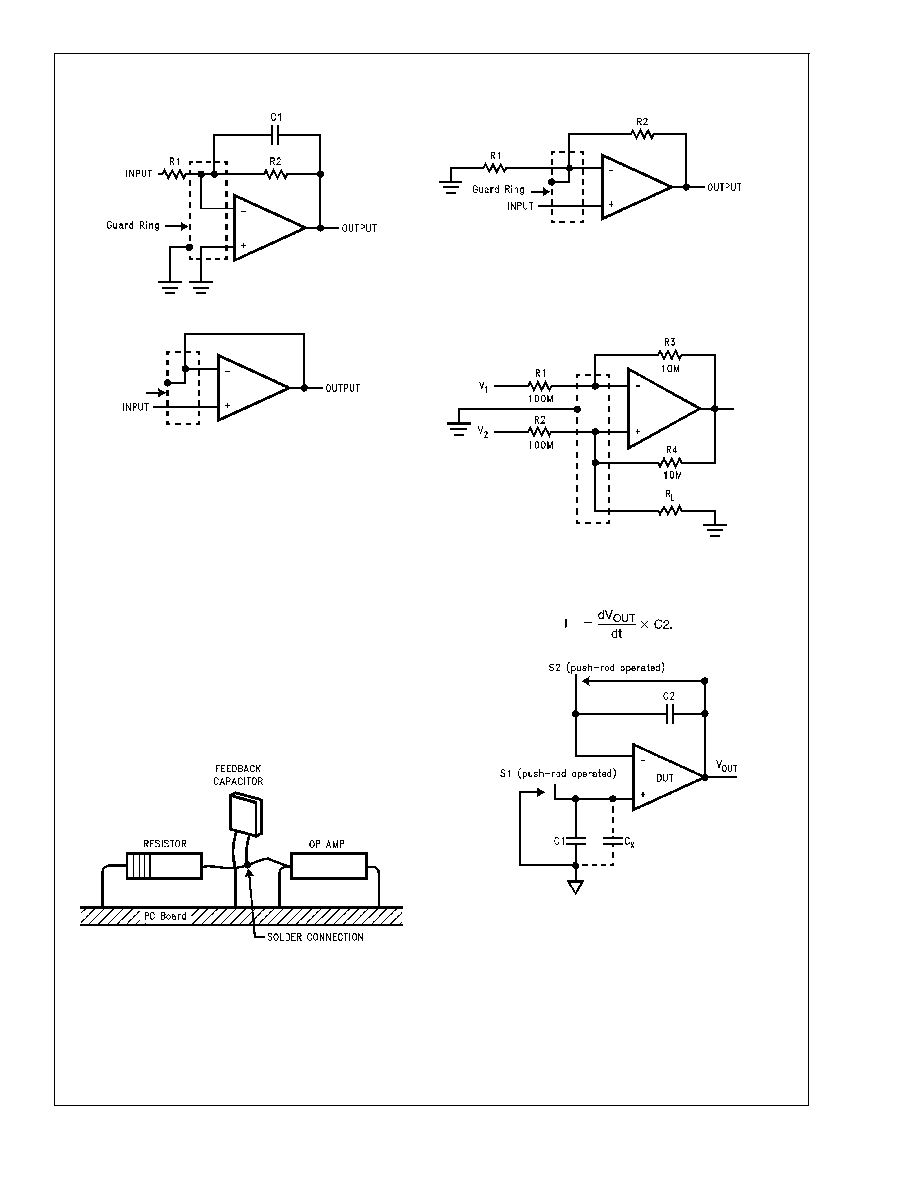
Application Hints
(Continued)
The designer should be aware that when it is inappropriate
to lay out a PC board for the sake of just a few circuits, there
is another technique which is even better than a guard ring
on a PC board: Don't insert the amplifier's input pin into the
board at all, but bend it up in the air and use only air as an in-
sulator. Air is an excellent insulator. In this case you may
have to forego some of the advantages of PC board con-
struction, but the advantages are sometimes well worth the
effort of using point-to-point up-in-the-air wiring. See
Figure
6.
BIAS CURRENT TESTING
The test method of
Figure 7 is appropriate for bench-testing
bias current with reasonable accuracy. To understand its op-
eration, first close switch S2 momentarily. When S2 is
opened, then
A suitable capacitor for C2 would be a 5 pF or 10 pF silver
mica, NPO ceramic, or air-dielectric. When determining the
magnitude of I
-
, the leakage of the capacitor and socket
must be taken into account. Switch S2 should be left shorted
most of the time, or else the dielectric absorption of the ca-
pacitor C2 could cause errors.
Similarly, if S1 is shorted momentarily (while leaving S2
shorted)
DS011236-9
(a) Inverting Amplifier
DS011236-10
(b) Non-Inverting Amplifier
DS011236-11
(c) Follower
DS011236-12
(d) Howland Current Pump
FIGURE 5. Guard Ring Connections
DS011236-13
(Input pins are lifted out of PC board and soldered directly to components.
All other pins connected to PC board.)
FIGURE 6. Air Wiring
DS011236-14
FIGURE 7. Simple Input Bias Current Test Circuit
LMC6022
www.national.com
11
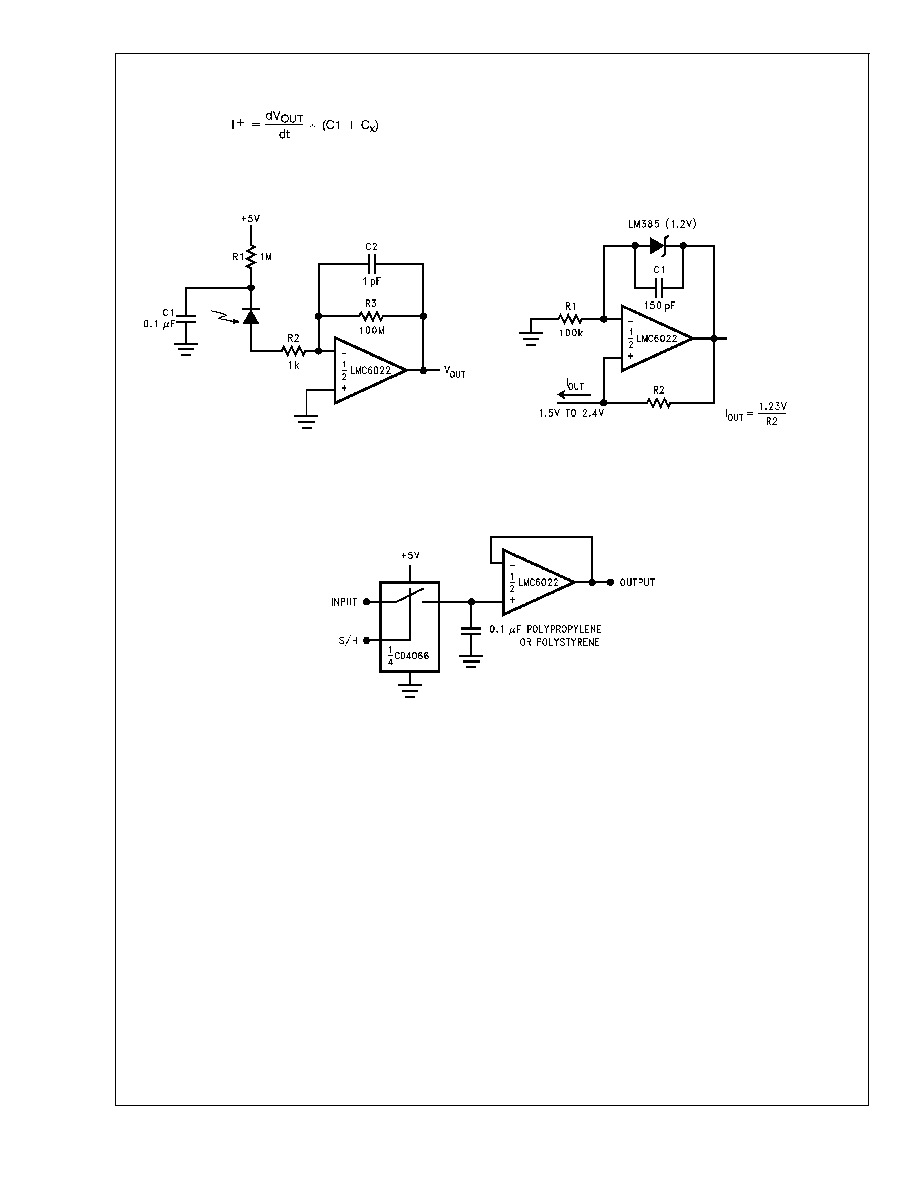
Application Hints
(Continued)
where C
x
is the stray capacitance at the + input.
Typical Single-Supply Applications
(V+ = 5.0 V
DC
)
Photodiode Current-to-Voltage Converter
DS011236-15
Note: A 5V bias on the photodiode can cut its capacitance by a factor of 2
or 3, leading to improved response and lower noise. However, this bias on
the photodiode will cause photodiode leakage (also known as its dark
current).
Micropower Current Source
DS011236-16
(Upper limit of output range dictated by input common-mode range; lower
limit dictated by minimum current requirement of LM385.)
Low-Leakage Sample-and-Hold
DS011236-17
LMC6022
www.national.com
12
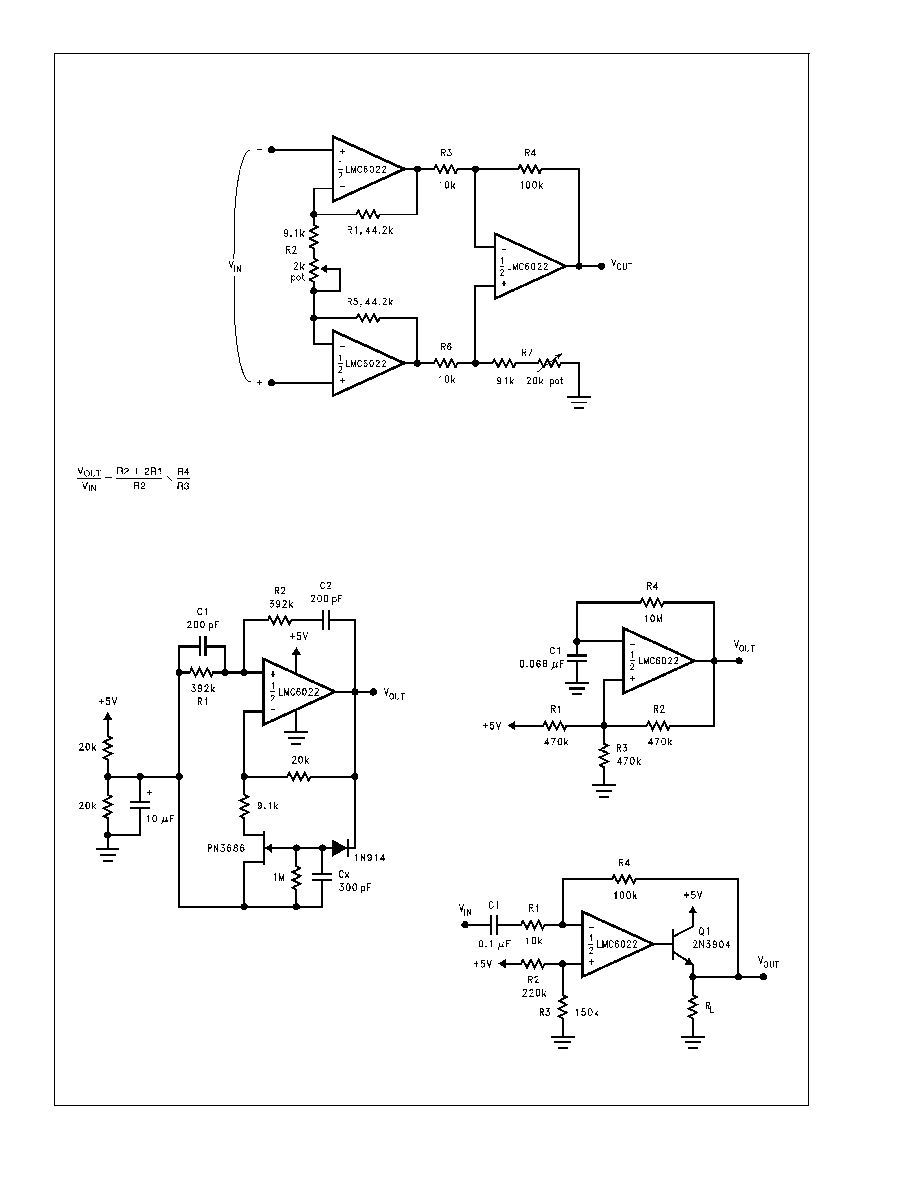
Typical Single-Supply Applications
(V+ = 5.0 V
DC
) (Continued)
This circuit, as shown, oscillates at 2.0 kHz with a
peak-to-peak output swing of 4.5V.
Instrumentation Amplifier
DS011236-18
If R1 = R5, R3 = R6, and R4 = R7;
Then
A
V
100 for circuit shown
For good CMRR over temperature, low drift resistors should be used. Matching of R3 to R6 and R4 to R7 affects CMRR. Gain may be adjusted through R2.
CMRR may be adjusted through R7.
Sine-Wave Oscillator
DS011236-19
Oscillator frequency is determined by R1, R2, C1, and C2:
f
OSC
= 1/2
RC
where R = R1 = R2 and C = C1 = C2.
1 Hz Square-Wave Oscillator
DS011236-20
Power Amplifier
DS011236-21
LMC6022
www.national.com
13
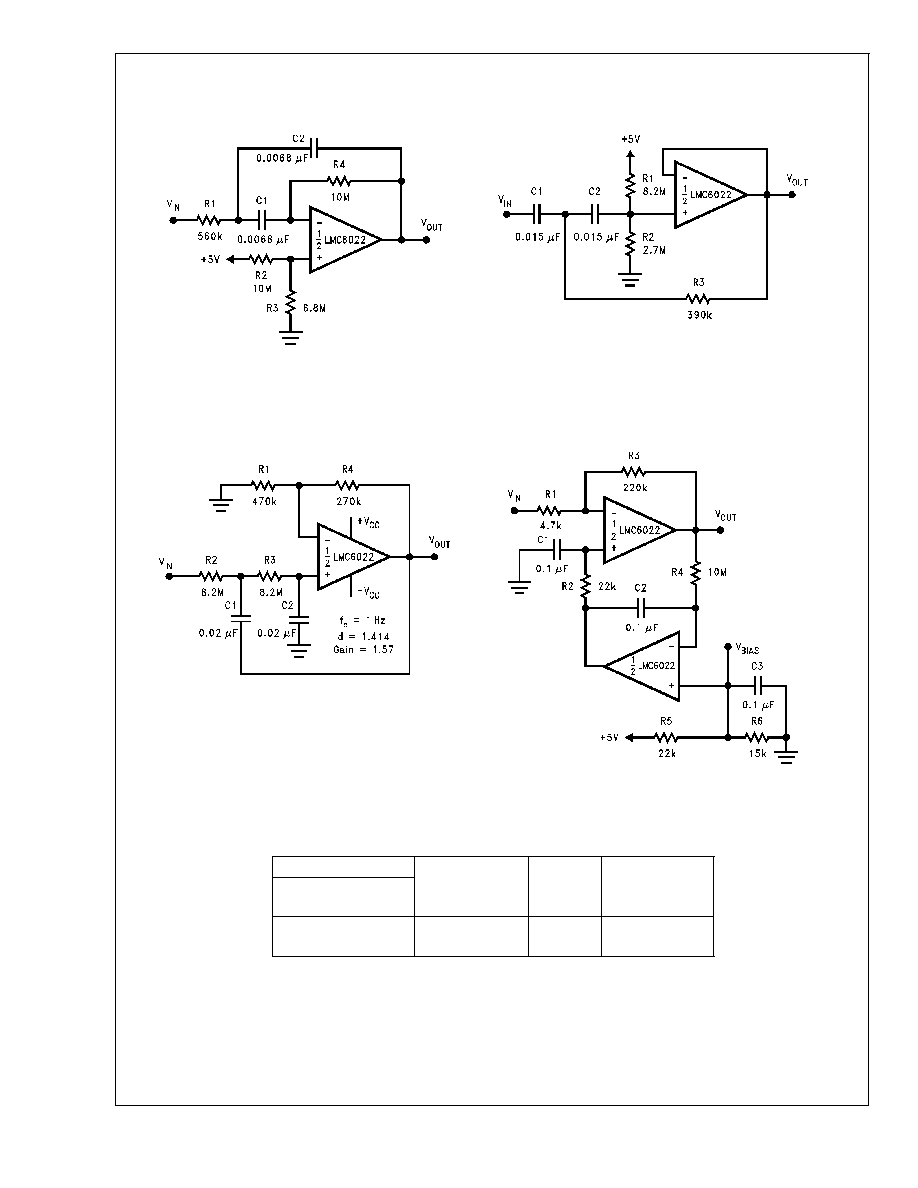
Typical Single-Supply Applications
(V+ = 5.0 V
DC
) (Continued)
Ordering Information
Temperature Range
Package
NSC
Drawing
Transport
Media
Industrial
-40∞C
T
J
+85∞C
LMC6022IM
8-Pin
M08A
Rail
LMC6022IMX
Small Outline
Tape and Reel
10 Hz Bandpass Filter
DS011236-22
f
O
= 10 Hz
Q = 2.1
Gain = -8.8
10 Hz High-Pass Filter (2 dB Dip)
DS011236-23
f
c
= 10 Hz
d = 0.895
Gain = 1
1 Hz Low-Pass Filter (Maximally Flat, Dual Supply
Only)
DS011236-24
High Gain Amplifier with Offset Voltage Reduction
DS011236-25
Gain = -46.8
Output offset voltage reduced to the level of the input offset voltage of the
bottom amplifier (typically 1 mV), referred to V
BIAS
.
LMC6022
www.national.com
14
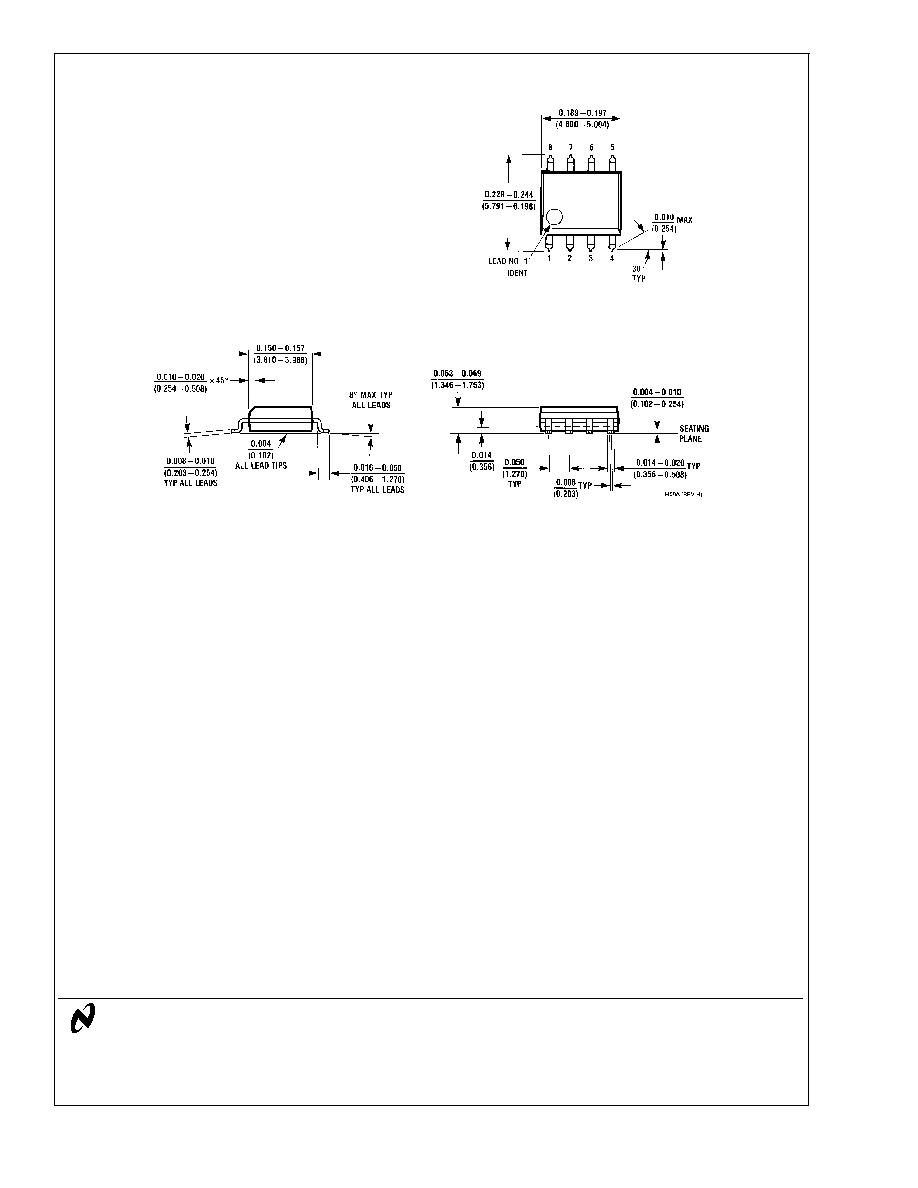
Physical Dimensions
inches (millimeters) unless otherwise noted
LIFE SUPPORT POLICY
NATIONAL'S PRODUCTS ARE NOT AUTHORIZED FOR USE AS CRITICAL COMPONENTS IN LIFE SUPPORT
DEVICES OR SYSTEMS WITHOUT THE EXPRESS WRITTEN APPROVAL OF THE PRESIDENT AND GENERAL
COUNSEL OF NATIONAL SEMICONDUCTOR CORPORATION. As used herein:
1. Life support devices or systems are devices or
systems which, (a) are intended for surgical implant
into the body, or (b) support or sustain life, and
whose failure to perform when properly used in
accordance with instructions for use provided in the
labeling, can be reasonably expected to result in a
significant injury to the user.
2. A critical component is any component of a life
support device or system whose failure to perform
can be reasonably expected to cause the failure of
the life support device or system, or to affect its
safety or effectiveness.
National Semiconductor
Corporation
Americas
Tel: 1-800-272-9959
Fax: 1-800-737-7018
Email: support@nsc.com
National Semiconductor
Europe
Fax: +49 (0) 180-530 85 86
Email: europe.support@nsc.com
Deutsch Tel: +49 (0) 69 9508 6208
English
Tel: +44 (0) 870 24 0 2171
FranÁais Tel: +33 (0) 1 41 91 8790
National Semiconductor
Asia Pacific Customer
Response Group
Tel: 65-2544466
Fax: 65-2504466
Email: ap.support@nsc.com
National Semiconductor
Japan Ltd.
Tel: 81-3-5639-7560
Fax: 81-3-5639-7507
www.national.com
8-Pin Small Outline Molded Package (M)
Order Number LMC6022IM
NS Package Number M08A
LMC6022
Low
Power
CMOS
Dual
Operational
Amplifier
National does not assume any responsibility for use of any circuitry described, no circuit patent licenses are implied and National reserves the right at any time without notice to change said circuitry and specifications.














